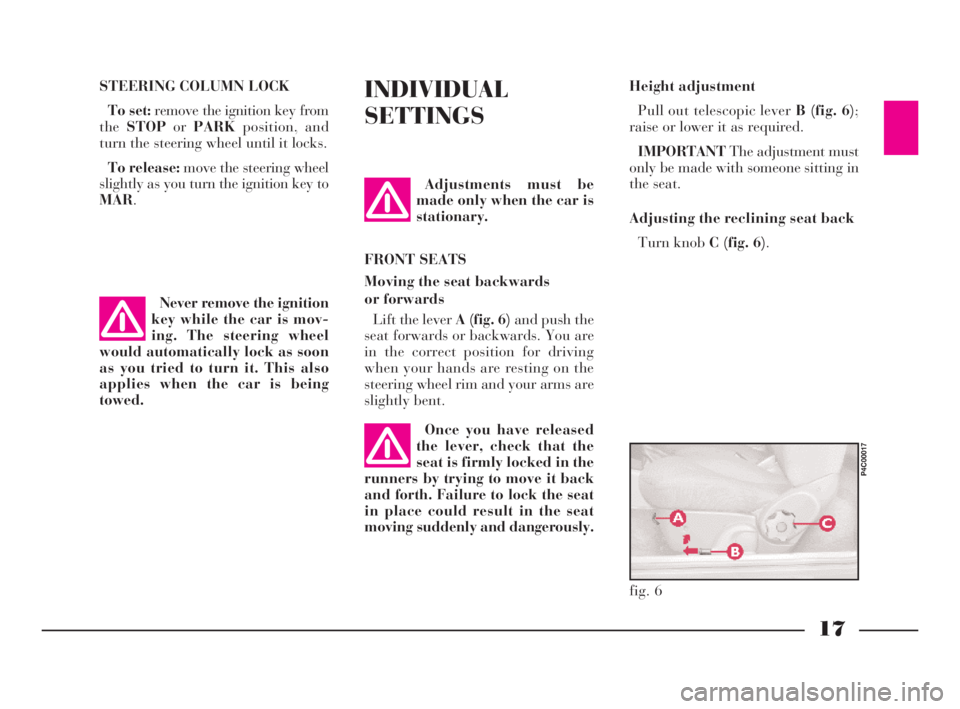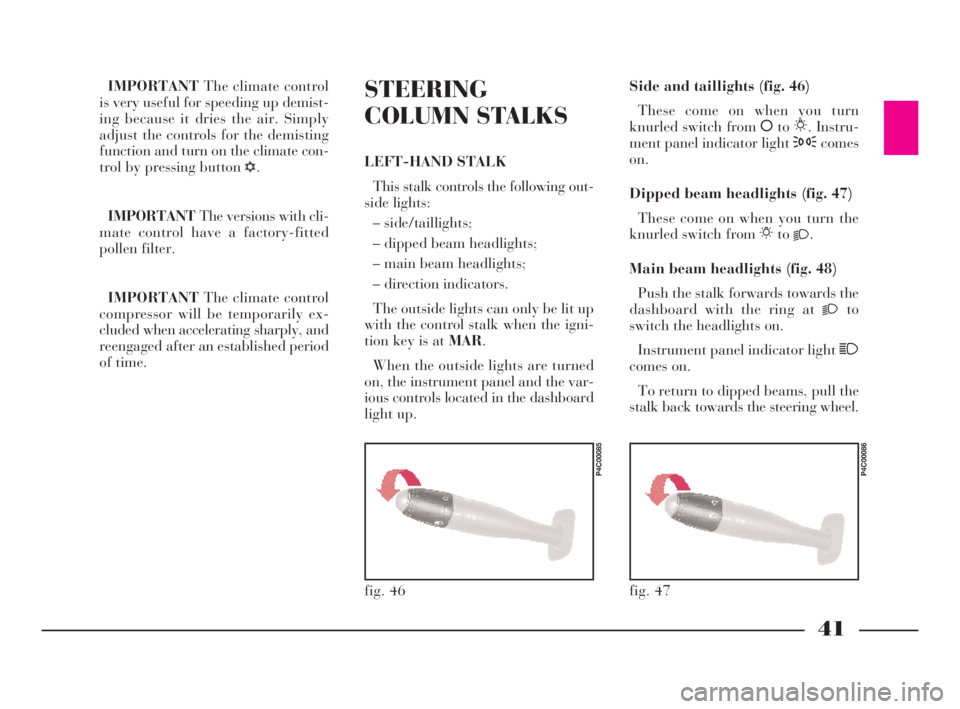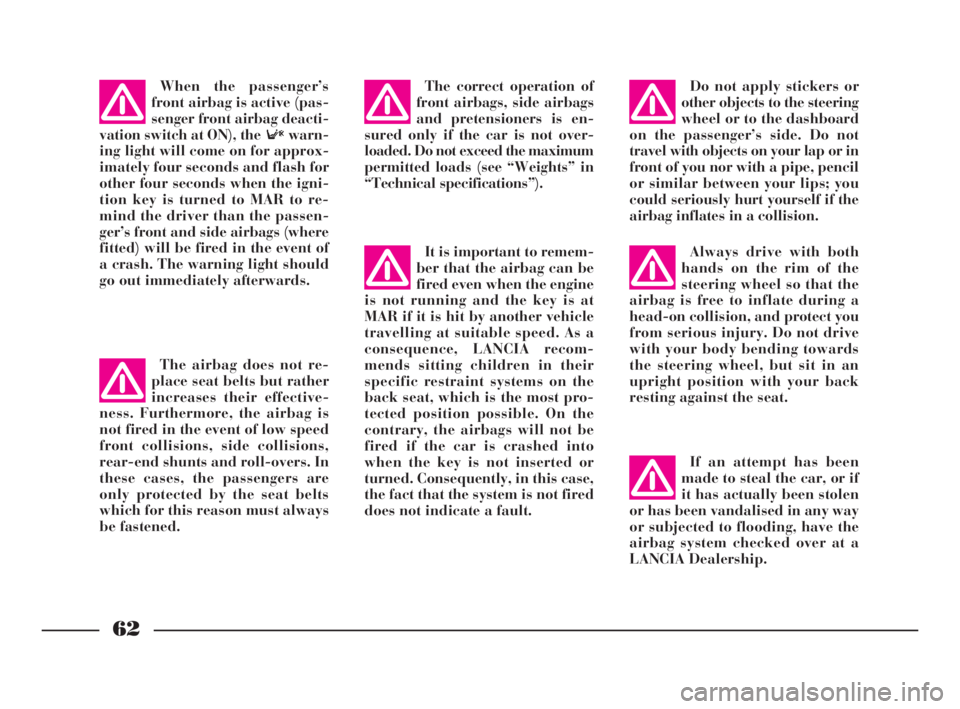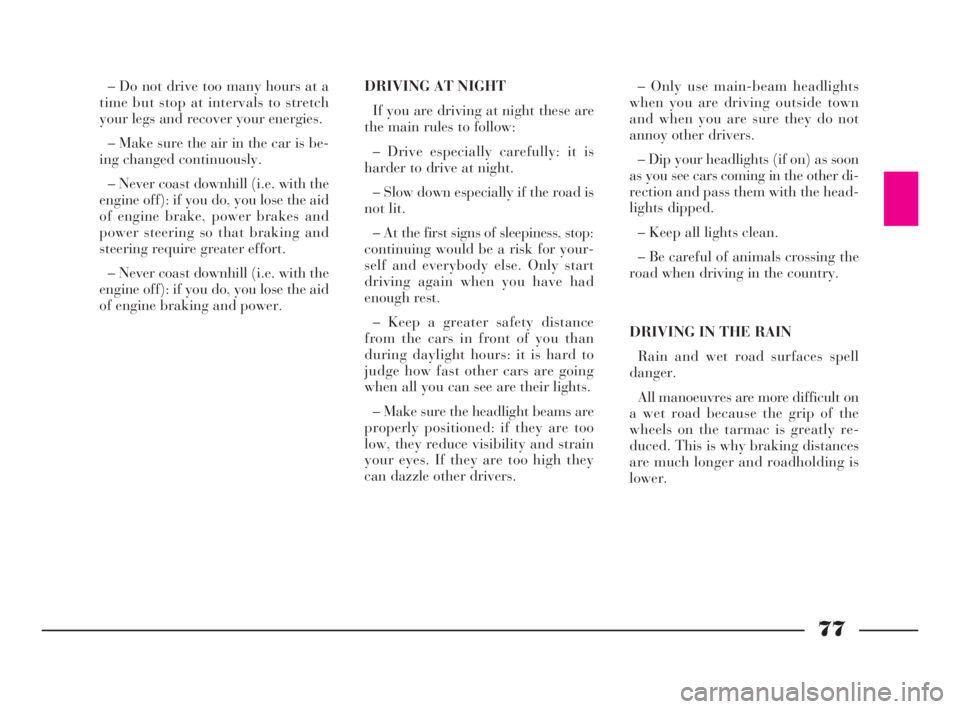tow Lancia Ypsilon 2002 Owner handbook (in English)
[x] Cancel search | Manufacturer: LANCIA, Model Year: 2002, Model line: Ypsilon, Model: Lancia Ypsilon 2002Pages: 191, PDF Size: 2.45 MB
Page 20 of 191

17
G
STEERING COLUMN LOCK
To set: remove the ignition key from
theSTOPorPARKposition, and
turn the steering wheel until it locks.
To release: move the steering wheel
slightly as you turn the ignition key to
MAR.
Never remove the ignition
key while the car is mov-
ing. The steering wheel
would automatically lock as soon
as you tried to turn it. This also
applies when the car is being
towed.INDIVIDUAL
SETTINGS
Adjustments must be
made only when the car is
stationary.
FRONT SEATS
Moving the seat backwards
or forwards
Lift the lever A (fig. 6)and push the
seat forwards or backwards. You are
in the correct position for driving
when your hands are resting on the
steering wheel rim and your arms are
slightly bent.Height adjustment
Pull out telescopic lever B (fig. 6);
raise or lower it as required.
IMPORTANTThe adjustment must
only be made with someone sitting in
the seat.
Adjusting the reclining seat back
Turn knob C (fig. 6).
fig. 6
P4C00017
Once you have released
the lever, check that the
seat is firmly locked in the
runners by trying to move it back
and forth. Failure to lock the seat
in place could result in the seat
moving suddenly and dangerously.
4C001-067 ING 11-03-2008 11:57 Pagina 17
Page 41 of 191

38
G
AIR VENTS (fig. 42 and 43)
The vents can be rotated upwards or
downwards.
A- Control for directing the air flow:
rotated towards
¥or
à= vent open;
rotated towards
ç= vent closed.
B- Control for regulating air flow.
C- Fixed vent for side windows
(fig. 43).
D - Fixed vent for front-seat pas-
senger(fig. 42).CONTROLS (fig. 44)
A- Air temperature knob (mixture
of hot/cold air).
B- Fan knob, which may have 3 or
4 speeds according to the version.
C- Air distribution knob.
D- Air recirculation slider. This pre-
vents air from being taken in from
outside.HEATING
1)Air temperature knob: pointer in
the red sector.
2)Fan knob: pointer set at the speed
required.
3)Air distribution knob: pointer set
at:
≤to warm the feet and demist the
windscreen at the same time;
≥to generally warm the passenger
compartment;
μto warm the feet and direct cooler
our towards the face (“bi-level” func-
tion).
4)Recirculation slider: to speed up
heating, move the air recirculation
slider to position T, which means
only inside air is recirculated.
fig. 42
P4C00325
fig. 43
P4C00081
fig. 44
P4C00212
4C001-067 ING 11-03-2008 11:57 Pagina 38
Page 44 of 191

41
G
IMPORTANTThe climate control
is very useful for speeding up demist-
ing because it dries the air. Simply
adjust the controls for the demisting
function and turn on the climate con-
trol by pressing button
√.
IMPORTANTThe versions with cli-
mate control have a factory-fitted
pollen filter.
IMPORTANTThe climate control
compressor will be temporarily ex-
cluded when accelerating sharply, and
reengaged after an established period
of time.STEERING
COLUMN STALKS
LEFT-HAND STALK
This stalk controls the following out-
side lights:
– side/taillights;
– dipped beam headlights;
– main beam headlights;
– direction indicators.
The outside lights can only be lit up
with the control stalk when the igni-
tion key is at MAR.
When the outside lights are turned
on, the instrument panel and the var-
ious controls located in the dashboard
light up.Side and taillights (fig. 46)
These come on when you turn
knurled switch from åto6. Instru-
ment panel indicator light 3comes
on.
Dipped beam headlights (fig. 47)
These come on when you turn the
knurled switch from 6to
2.
Main beam headlights (fig. 48)
Push the stalk forwards towards the
dashboard with the ring at
2to
switch the headlights on.
Instrument panel indicator light 1
comes on.
To return to dipped beams, pull the
stalk back towards the steering wheel.
fig. 46
P4C00085
fig. 47
P4C00086
4C001-067 ING 11-03-2008 11:57 Pagina 41
Page 45 of 191

42
G
RIGHT-HAND STALK
Windscreen wash/wipe (fig. 51)
This feature can only work when the
ignition key is at MAR.
Controls:
0- windscreen wiper off;
1- flick wipe;
2- slow continuous wipe;
3- fast continuous wipe;
4- temporary function: when you
release the stalk it returns to position
0and automatically turns off the
windscreen wiper.
fig. 51
P4C00090
To flash the lights (fig. 49)
Pull the stalk towards the steering
wheel (temporary position).Direction indicators (fig. 50)
Move the stalk as follows to turn on
the direction indicators:
up - for the right indicator;
down - for the left indicator.
Instrument panel indicator light y
flashes.
The direction indicators automati-
cally return to the neutral position
when the car straightens up.
If you want the indicator to flash
briefly, move the stalk up or down
without it clicking into position. When
you let it go it will return to its origi-
nal position.
fig. 48
P4C00087
fig. 49
P4C00088
fig. 50
P4C00089
4C001-067 ING 11-03-2008 11:57 Pagina 42
Page 46 of 191

43
G
When you pull the lever towards the
steering wheel (fig. 52), a jet of liquid
shoots out from the windscreen
washer.Rear window wash/wipe (fig. 53)
This function is only possible when
the ignition key is at MAR.
Controls:
1)turn the control from åto'for
continous wiper operation;
2)when you push the control stalk
forward (temporary position), a jet of
liquid shoots out from the rear win-
dow washer and the rear window
wiper comes into operation. When you
let the lever go again the rear window
washer/ wiper ceases to function.
fig. 52
P4C00091
fig. 53
P4C00092
CONTROLS
HAZARD LIGHTS
These come on when switch A
(fig. 54)is pressed, regardless of the
position of the ignition key.
When these lights are on, the panel
warning light
rflashes.
Press the switch again to turn the
lights off.
fig. 54
P4C00343
4C001-067 ING 11-03-2008 11:57 Pagina 43
Page 55 of 191

52
G
4)Fold the seat back forwards to
make a flat loading surface with the
boot floor (fig. 78).
If necessary, the cushion can also be
tilted(fig. 79). Consequently, before
releasing the seat back, lift the cush-
ion as shown and tip it against the
front seat backs; the rear seat back-
rest can then be released and tilted
forwards.
To return the seat to its normal po-
sition:
1)Return the seat back to the verti-
cal position and make sure it is prop-
erly locked into place; the red strip on
the hook-up button must disappear.
fig. 77
P4C00034
Removing the parcel shelf
If you wish to remove the parcel
shelf to extend the boot capacity, un-
hook the two tie-rods (one each side)
A (fig. 75)from the hooks B, then
pull the parcel shelf outwards so that
pinsCcome out.
The shelf can then be positioned be-
hind the front seats.INCREASING THE LOAD AREA
Proceed as follows:
1)Make sure that the side seat belts
A (fig. 76)have been inserted into the
corresponding bracket B.
2)Remove the rear head restraints
if required.
3)Release the seat back by pressing
buttonA (fig. 77)(one for each side)
located on the back seat back-rest
(even when a split back seat is fitted);
a red strip will appear on the short
side of the button (towards the inside
of the car) to indicate that it has been
released.
fig. 75
P4C00009
fig. 76
P4C00052
Heavy loads which are
not securely anchored
could seriously injure pas-
sengers in the event of an accident.
4C001-067 ING 11-03-2008 11:57 Pagina 52
Page 65 of 191

62
G
It is important to remem-
ber that the airbag can be
fired even when the engine
is not running and the key is at
MAR if it is hit by another vehicle
travelling at suitable speed. As a
consequence, LANCIA recom-
mends sitting children in their
specific restraint systems on the
back seat, which is the most pro-
tected position possible. On the
contrary, the airbags will not be
fired if the car is crashed into
when the key is not inserted or
turned. Consequently, in this case,
the fact that the system is not fired
does not indicate a fault.Always drive with both
hands on the rim of the
steering wheel so that the
airbag is free to inflate during a
head-on collision, and protect you
from serious injury. Do not drive
with your body bending towards
the steering wheel, but sit in an
upright position with your back
resting against the seat.
If an attempt has been
made to steal the car, or if
it has actually been stolen
or has been vandalised in any way
or subjected to flooding, have the
airbag system checked over at a
LANCIA Dealership. Do not apply stickers or
other objects to the steering
wheel or to the dashboard
on the passenger’s side. Do not
travel with objects on your lap or in
front of you nor with a pipe, pencil
or similar between your lips; you
could seriously hurt yourself if the
airbag inflates in a collision.
The correct operation of
front airbags, side airbags
and pretensioners is en-
sured only if the car is not over-
loaded. Do not exceed the maximum
permitted loads (see “Weights” in
“Technical specifications”).When the passenger’s
front airbag is active (pas-
senger front airbag deacti-
vation switch at ON), the warn-
ing light will come on for approx-
imately four seconds and flash for
other four seconds when the igni-
tion key is turned to MAR to re-
mind the driver than the passen-
ger’s front and side airbags (where
fitted) will be fired in the event of
a crash. The warning light should
go out immediately afterwards.
The airbag does not re-
place seat belts but rather
increases their effective-
ness. Furthermore, the airbag is
not fired in the event of low speed
front collisions, side collisions,
rear-end shunts and roll-overs. In
these cases, the passengers are
only protected by the seat belts
which for this reason must always
be fastened.
4C001-067 ING 11-03-2008 11:57 Pagina 62
Page 71 of 191

DRIVING YOUR CAR
To help you handle your car in the best and
safest possible way, and above all use it to its fullest
potential, we have given you some hints in this
chapter on “what to do, what not to do and what
to avoid” when at the wheel of your Lancia Y.
Most of the time, these suggestions apply to
other cars as well. Sometimes, however, the tip
may apply to an exclusive Lancia Y feature. You
are therefore strongly recommended to pay the
closest attention to this section for helpful hints
on optimum driving practices and usage of the car
that will help you get the most out of your car. STARTING THE ENGINE .............................. 69
PARKING ....................................................... 71
GEAR USE ..................................................... 72
AT THE FILLING STATION .......................... 73
SAFE DRIVING .............................................. 75
CONTAINING RUNNING COSTS
AND POLLUTION ......................................... 81
CHEAP RUNNING THAT RESPECTS
THE ENVIRONMENT ................................... 83
TOWING A TRAILER .................................... 84
SNOW CHAINS .............................................. 85
SNOW TYRES ................................................ 86
STORING THE CAR ...................................... 87
REPEATED CHECKS AND CHECKS
BEFORE LONG TRIPS .................................. 88
ACCESSORIES PURCHASED
BY THE OWNER ........................................... 88
USEFUL ACCESSORIES ............................... 89
68
G
4C068-089 ING 11-03-2008 11:59 Pagina 68
Page 73 of 191

70
G
HOW TO WARM UP
THE ENGINE AFTER
IT HAS JUST STARTED
– Begin to move forward slowly let-
ting the engine turn over at medium
revs. Do not accelerate abruptly.
– Do not push the engine to its limit
for the first few kilometres. You are
recommended to wait until the water
temperature has reached 50°C to
60°C (pointer moves slightly from its
initial position).
EMERGENCY STARTING
If the Lancia CODE system fails to
recognise the code transmitted by the
ignition key (warning lamp ¢on in-
strument panel lit with a fixed light),
you can start the engine by following
the emergency procedure using the
code written on the CODE card.
See the section “In an emergency”.STOPPING THE ENGINE
Turn the ignition key to STOPwhile
the engine is idling.
Remember that as long as
the engine is not running,
the brake booster and
power steering do not work. You
therefore have to use considerably
more effort on both the brake
pedal and the steering wheel.
Bump starting by push-
ing, towing or rolling
downhill must be avoided
at all costs. This way of starting
could cause a rush of fuel into the
catalytic exhaust pipe and damage
it beyond repair.
BUMP STARTING
A quick burst on the ac-
celerator before turning off
the engine serves ab-
solutely no practical purpose, and
wastes fuel.
IMPORTANTAfter a taxing drive it
is better to allow the engine to “catch
its breath” before turning it off by let-
ting it idle to allow the temperature in
the engine compartment to fall.
4C068-089 ING 11-03-2008 11:59 Pagina 70
Page 80 of 191

77
G
– Only use main-beam headlights
when you are driving outside town
and when you are sure they do not
annoy other drivers.
– Dip your headlights (if on) as soon
as you see cars coming in the other di-
rection and pass them with the head-
lights dipped.
– Keep all lights clean.
– Be careful of animals crossing the
road when driving in the country.
DRIVING IN THE RAIN
Rain and wet road surfaces spell
danger.
All manoeuvres are more difficult on
a wet road because the grip of the
wheels on the tarmac is greatly re-
duced. This is why braking distances
are much longer and roadholding is
lower. DRIVING AT NIGHT
If you are driving at night these are
the main rules to follow:
– Drive especially carefully: it is
harder to drive at night.
– Slow down especially if the road is
not lit.
– At the first signs of sleepiness, stop:
continuing would be a risk for your-
self and everybody else. Only start
driving again when you have had
enough rest.
– Keep a greater safety distance
from the cars in front of you than
during daylight hours: it is hard to
judge how fast other cars are going
when all you can see are their lights.
– Make sure the headlight beams are
properly positioned: if they are too
low, they reduce visibility and strain
your eyes. If they are too high they
can dazzle other drivers. – Do not drive too many hours at a
time but stop at intervals to stretch
your legs and recover your energies.
– Make sure the air in the car is be-
ing changed continuously.
– Never coast downhill (i.e. with the
engine off): if you do, you lose the aid
of engine brake, power brakes and
power steering so that braking and
steering require greater effort.
– Never coast downhill (i.e. with the
engine off): if you do, you lose the aid
of engine braking and power.
4C068-089 ING 11-03-2008 11:59 Pagina 77